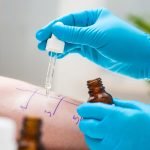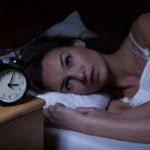Sleep: The Emerging Science & Its Clinical Implications
Krista Anderson-Ross, ND
Tolle Totum
Sleep is a criminal waste of time, inherited from our cave days.
(Thomas Edison)
While it’s easy to believe that sleep deprivation is a manifestation of the modern world and the effects of increasingly occupied opposable thumbs, the first known study on the negative effects of sleeplessness was published in 1896 in the Journal of Psychological Review, just 17 years after the invention of the light bulb.1 Thus was born the industrial revolution, a 24-hour work force, and the wakeful work ethic.
Sleep is a Hot Commodity
A 2017 New York Times article entitled, “Sleep is the New Status Symbol” outlined the bourgeoning “sleep industry,” a $32 billion market in 2012, ranging from sleep clinics to expensive gadgets for promoting sleep, including weighted blankets, swinging beds, Icelandic fairy tales, and goggles that reflect light into the eye.2 Additional signs of the times are TED talks on sleep, and smartphone apps that range from sophisticated sleep-tracking systems to boring bedtime stories designed to lull the listener to sleep.
A recent campaign by the Centers for Disease Control & Prevention (CDC) stated that 35% of the population isn’t getting the recommended 7 hours of sleep.3 The CDC cites statistics related to “sleep-related difficulties,” including concentration, remembering, driving, and working. The Behavioral Risk Factor Surveillance System survey of 2009 determined that 37.9% of 74 571 adult respondents over the age of 18 reported unintentionally falling asleep during the day at least once in the preceding month, and 4.7% reported nodding off or falling asleep while driving at least once in the preceding month.3
In 2014, the Norwegian HUNT study – a population-based, prospective cohort study that followed 54 399 men and women – concluded that insomnia (ie, difficulty initiating or maintaining sleep, and/or a feeling of nonrestorative sleep) was responsible for 8% of all unintentional fatal injuries and 34% of all fatal motor vehicle injuries.4 The authors attributed these statistics to lack of sufficient daytime alertness, compromised cognitive function, and impaired psychomotor performance capabilities associated with insufficient sleep.
A small Australian study in 1997 examined the impact that fatigue had on performance. The researchers concluded that moderate levels of fatigue produced higher levels of impairment than did alcohol intoxication: being awake for 18 hours (8 AM – midnight) produced a functional impairment equal to the impairment induced by a blood alcohol concentration (BAC) of .05, while being awake for 24 hours produced a functional impairment equal to that of a BAC of .10.5 (A BAC of .08 is considered legally drunk, and for commercial drivers the level is .04.) In 2013, drowsy drivers caused 72 000 car accidents in which 800 Americans were killed and 41 000 were injured.6
We Are Mammals, After All
Mammalian circadian clocks evolved as an adaptive response to the daily cycles associated with the earth’s rotation and the solar day. As a result, most physiological processes in the human body oscillate in a daily fashion.
Every cell in the human body contains a genetically-based molecular clock that generates internal timing of approximately 24 hours in the absence of external cues. The suprachiasmatic nucleus (SCN), located in the hypothalamus, serves as omnipotent pacemaker (or “master clock”), as it is the only molecular clock that receives light input from the retina, synchronizing internal clock timing and coordinating peripheral clocks into a 24-hour circadian rhythm.7
There is a broad spectrum of human diurnal tendencies, or “temporal preferences,” influencing this rhythm, where individuals lean more toward morningness (“larks”) or eveningness (“owls”), with most people landing somewhere in-between. These tendencies, known as “chronotypes,” tend to correlate with individuals’ self-reported alertness and performance efficiency based on the Horne-Ostberg Morningness-Eveningness Questionnaire8 and the Munich Chronotype Questionnaire.9 Chronotypes change predictably with developmental age, with eveningness being particularly prevalent among adolescents, and morningness being more prevalent among older individuals.
While attempts to correlate circadian gene polymorphisms and chronotypes have produced contradictory results, polymorphisms in human clock genes have been shown to correlate with alterations in sleep or diurnal preference. Such polymorphisms can have a profound effect on sleep and other forms of cyclic behavior. For example, a polymorphism in the gene PER3 is correlated with delayed sleep phase syndrome, whereas a mutation in PER2 is associated with familial advanced sleep phase syndrome.10
Understanding the tendencies for temporal preference among patients can help guide a provider toward the necessary lifestyle modifications to restore synchrony. While few patients will fall into the category of “internal desynchronization” – defined as the frank misalignment between one’s endogenous circadian rhythm and the light-dark cycle – many fall on the far ends of the spectrum, such that imbalance is severe enough to greatly impact daily functioning and sleep.11
How Did We Get Here?
Consolidated sleep in human beings may be an artifact of modern lighting technology. The notion of “sleeping through the night” over 1 consolidated time period is relatively new in human evolution. Segmented sleep seems to have been the norm until the advent of artificial lighting. Medical texts of the 1800s still refer to “first sleep” or “dead sleep,” and “second sleep” or “morning sleep.” People used to sleep in two 4-hour periods from sunset to sunrise, with a break in-between to tend to such chores as caring for animals and stoking fires. The advent of the light bulb diminished nighttime darkness, and day “light” increased, thereby consolidating the work day and necessitating that sleep fit into one 8-hour period.12
Perhaps what is frequently observed or reported as a “sleep problem” has more to do with one’s natural rhythms being out of sync with the demands of the modern world. It is important to recognize and honor a patient’s natural tendencies when attempting to phase-shift sleeping tendencies. The morningness/eveningness score can be a useful tool to help elucidate one’s needs and preferences and to help guide treatment options. For example, evening-type individuals have been found to be well-suited to night-shift work.13 These tendencies may also dictate when one’s levels of performance and productivity are at their highest and lowest throughout the day, the awareness of which may lead to increased performance in academia and the work place.
While there is great variability in the timing of sleep and circadian rhythms within the human population, recent evidence suggests that light exposure is the most powerful exogenous factor influencing individual differences in sleep and circadian timing. The individual tendency to have a very delayed schedule (phase delay) is greatly amplified by artificial light.14
Light & Melatonin in Sleep Phase Shifting
In humans, circulating melatonin derives exclusively from the pineal gland. (Synthesis also takes place in other tissues, including the retina, gut, and bone marrow, but this melatonin works only locally, with autocoid and paracoid functions.) The biosynthesis of melatonin occurs predominantly during the night phase of the light-dark (LD) cycle and is regulated by the SCN, but the duration, phase, and amplitude are influenced by changes in the light-dark cycle. Photoreceptor cells in the retina perceive light, which regulates melatonin synthesis. In most people, the plasma melatonin level begins to increase steadily between 1900 h and 2300 h under the influence of dim light, and reaches its peak value between 0200 h and 0400 h. Levels are at their lowest during daytime hours under the influence of light.10
While light is a key factor controlling the secretion of melatonin, its spectrum and intensity, the time of day, and duration of exposure all play influential roles in melatonin synthesis. Exposure to light in the morning results in a phase advance of the melatonin curve, which means that the peak of melatonin secretion will occur earlier. Conversely, when the exposure takes place at the end of the afternoon prior to the nadir for core body temperature, the phase is delayed, with a later peak. An exposure to light between midnight and 4 AM, during the normal peak of melatonin secretion, results in a complete inhibition of secretion for the full duration of the exposure.15
Light in the evening prior to bedtime and in the first part of sleep has been shown to delay circadian timing. Light in the morning before and after natural wake time phase advances circadian timing. These principles hold true regardless of whether one suffers from sleep-onset insomnia, or a phase advance where one falls asleep at night and wakes earlier in the morning than desired.16 Generally speaking, daily exposure to a daily white, broad-spectrum bright-light treatment for approximately 1 hour before one’s usual bedtime will phase-delay the onset of sleep by approximately 1 hour, whereas exposure to the same light treatment for approximately 1 hour around wake-time will phase-advance the onset of sleep by approximately 1 hour.17
Which light to choose? Light intensity is reported in units of lux. The very bright light of a sunny, cloudless day (also known as “full-spectrum light”) can be as high as 100 000 lux. Rainy days are about 1000 lux, and the light at sunrise/sunset is about 400 lux under a clear sky.18 Bright-light boxes claim to emit 10 000 lux, which is measured at the light box itself; however, when measured at the eye level of the user about 2 feet away, the lux level is closer to 3000-5000 lux. Indoor lighting is typically 100-200 lux. In their experiments, Emens and Burgess used 10 000-lux light boxes at a 2-foot distance from the subject, to ensure an exposure of 3000 lux.16
While many studies have concluded that blue light from technological devices (cell phones, tablets, computers, television) has the most pronounced suppressant effect on melatonin production,10,17,18 a recent small study by Rangtel et al casts some doubt on this conclusion.19 Rangtel’s study of 14 adults sought to explore how controlled, full-spectrum light exposure (approximately 569 lux) preceding tablet use might affect sleep. Their main finding was that evening use of a self-luminous tablet set to full brightness for 2 hours between 2100 h and 2300 h following 6.5 hours of full-spectrum light exposure did not affect self-reported sleepiness, saliva melatonin levels before sleep, time to fall asleep, or time spent asleep.19 Other studies have demonstrated that daytime bright light exposure between 1300 h and 1900 h attenuates the suppressive properties of evening blue light on melatonin levels. The potential for bright light to reduce or reverse the melatonin-suppressing effects of blue light is encouraging, given the widespread popularity of mobile devices (30% of US students are using devices issued by their schools20 and 96% of people under the age of 30 report using screen-based technological devices within 1 hour of trying to sleep21).
Magical Melatonin
Melatonin serves the all-important role of “chronobiotic,” both in its ability to adjust the timing of internal biological rhythms and to induce sleep. Melatonin has an inverse relationship with body temperature and cortisol, and plays an important role in regulating the circadian rhythm of these hormones.22 As melatonin levels begin their slow ascent in late afternoon/early evening, body temperature begins to fall, reaching its nadir when melatonin levels are at their highest in the middle of the night. As well, cortisol levels reach their nadir in the middle of the night when melatonin levels are highest. Just after melatonin peaks and begins to drop, temperature and cortisol begin their climb, with cortisol’s peak occurring 30 minutes after waking, and temperature reaching daytime levels at approximately the same time. Melatonin levels remain consistent until approximately age 55, when production begins to decline.10 Exogenous melatonin has been shown to have acute sleepiness-inducing and temperature-lowering effects, and with appropriate timing can shift the circadian clock earlier or later.23
Brzezinski et al, in their meta-analysis of 17 studies involving 284 individuals, concluded that melatonin is effective at reducing sleep-onset latency and increasing sleep efficiency.24 Researchers disagree with respect to the ideal time to administer melatonin for phase-advance purposes. In one study, 5 mg of melatonin, administered 5 hours before sleep onset, advanced sleep-onset time by about 1.3 hours and wake time by 2 hours, compared with placebo over a 4-6 week treatment period.25 Many studies suggest that the ideal time for melatonin dosing is 6 hours before mid-sleep. The Polish Psychiatric Association is in agreement with this recommendation and includes in their “Treatment Guidelines for Circadian Rhythm Sleep-Wake Disorders” an extensive chart indicating the most ideal times to take melatonin relative to one’s typical onset of sleep.26 For example, the ideal melatonin dosing time for a person who falls asleep at midnight, based on an 8-hour sleep period, would be 10 PM; for a person who falls asleep at 1 AM, ideal dosing time would be 11 PM, etc.
Dosing can be confusing for providers, as misinformation is readily available suggesting that exogenous melatonin suppresses endogenous production. Oral melatonin (500 mcg), administered to shift workers over a 1-week period, did not influence basal secretion as compared to secretion status prior to supplementation.27 Melatonin studies exploring dosing and suppression are often performed on the blind, as they are a population whose levels will not be influenced by sunlight. In a study conducted on a blind subject, 37 days of supplementation with 50 mg of melatonin resulted in no change in endogenous production.27 Studies have shown that 0.3, 0.5, 3 and 5 mg doses have been equally effective at treating delayed phase sleep syndrome.28 Research suggests that the higher doses (3 mg and 5 mg) are associated with a significant decline in core body temperature, whereas the lower, physiologic doses have no such effect.29,30
In addition to its sleep-phase effects, melatonin has other important qualities. For example, it has been found to be effective as both an anxiolytic and analgesic, thus effective for migraines, irritable bowel syndrome, and peri-operative pain and anxiety.31 Melatonin also has antioxidant and anti-inflammatory effects, and seems to meet the criteria for a mitochondria-targeted antioxidant.32 As such, it is one of our most prolific anti-cancer allies. Melatonin improves the sensitivity of cancers to conventional drugs, including cancers previously resistant to treatment.33 It inhibits metastasis and reduces the toxicity of anti-cancer drugs, as well as stimulates apoptosis, regulates tumor metabolism, and inhibits metastasis, angiogenesis, and induction of epigenetic alteration.33 Evidence is accumulating regarding chronically low levels of melatonin in mental illness, including depression and schizophrenia.34,35
Melatonin is available in both fast-acting and sustained-release formulations. In studies using oral, immediate-release melatonin, by Markantonis et al36 and Demuro et al,37 the half-life of melatonin was found to be 45.6-51.6 and 59-65 minutes, respectively. Sustained-release formulations taken at bedtime are slowly released over a 3-5-hour time-frame.38 Sustained-release melatonin may thus be more effective for those who experience difficulty staying asleep, while fast-acting melatonin can be dosed as described above for phase advancing.
Summary
Internal desynchronization is the misalignment between endogenous circadian rhythms and sleep-wake cycles. Under the influence of 120 years of modern lighting and technology, many try to fit into a sleep-wake cycle that is not congruent with their natural tendencies; this can lead to sleep shortage and circadian rhythm disruption. Assessing patients’ natural tendencies through the Horne-Ostberg and Munich Chronotype Questionnaires, and querying lifestyle influences, such as sleep habits and exposure to light, can be valuable tools in assessing a patient’s level of sleep dysfunction. Awareness of these individual tendencies, in combination with the chronobiotic effects of full-spectrum light and melatonin, can help guide providers and patients toward lifestyle choices that promote a healthier sleep-wake cycle and, in turn, a more productive work and personal life.
[References]:- Patrick GTW, Gilbert JA. Studies from the psychological laboratory of the University of Iowa: On the effects of loss of sleep. Psychol Rev. 1896;3(5):469-483.
- Green P. Sleep is the New Status Symbol. April 8, 2017. The New York Times. NYT Web site. https://www.nytimes.com/2017/04/08/fashion/sleep-tips-and-tools.html. Accessed January 4, 2018.
- Centers for Disease Control and Prevention. Sleep and Sleep Disorders. Last updated June 5, 2017. CDC Web site. https://www.cdc.gov/sleep/about_us.html. Accessed January 4, 2018.
- Laugsand LE, Strand LB, Vatten LJ, et al. Insomnia symptoms and risk for unintentional fatal injuries—the HUNT Study. Sleep. 2014;37(11):1777-1786.
- Dawson D, Reid K. Fatigue, alcohol and performance impairment. Nature. 1997;388(6639):235-235.
- National Highway Traffic Safety Administration. Traffic Safety Facts. March 2011. NHTSA’s National Center for Statistics and Analysis. Available at: https://crashstats.nhtsa.dot.gov/Api/Public/ViewPublication/811449. Accessed January 5, 2018.
- Partch CL, Green CB, Takahashi JS. Molecular Architecture of the Mammalian Circadian Clock. Trends Cell Biol. 2014;24(2):90-99.
- Horne JA, Ostberg O. A self-assessment questionnaire to determine morningness-eveningness in human circadian rhythms. Int J Chronobiol. 1976;4(2):97-110.
- Zavada A, Gordijn MC, Beersma DG, et al. Comparison of the Munich Chronotype Questionnaire with the Horne-Ostberg’s Morningness-Eveningness Score. Chronobiol Int. 2005;22(2):267-278.
- Pandi-Perumal SR, Trakht I, Spence DW, et al. The roles of melatonin and light in the pathophysiology and treatment of circadian rhythm sleep disorders. Nat Clin Pract Neurol. 2008;4(8):436-447.
- Katzenberg D, Young T, Finn L, et al. A CLOCK polymorphism associated with human diurnal preference. Sleep. 1998;21(6):569-576.
- Ekirch AR. Segmented sleep in preindustrial societies. Sleep. 2016;39(3):715-716.
- Akerstedt T. Shift work and sleep disorders. Sleep. 2005;28(1):9-11.
- Swaminathan K, Klerman EB, Phillips AJK. Are Individual Differences in Sleep and Circadian Timing Amplified by Use of Artificial Light Sources? J Biol Rhythms. 2017;32(2):165-176.
- Sugden D. Melatonin biosynthesis in the mammalian pineal gland. Experientia. 1989;45(10):922-932.
- Emens JS, Burgess HJ. Effect of Light and Melatonin and Other Melatonin Receptor Agonists on Human Circadian Physiology. Sleep Med Clin. 2015;10(4):435-453.
- Burgess HJ, Fogg LF, Young MA, et al. Bright light therapy for winter depression – Is phase advancing beneficial? Chronobiol Int. 2004;21:759-775.
- Crowley SJ, Molina TA, Burgess HJ. A week in the life of full-time office workers: work day and weekend light exposure in summer and winter. Appl Ergon. 2015;46 Pt A:193-200.
- Rångtell FH, Ekstrand E, Rapp L, et al. Two hours of evening reading on a self-luminous tablet vs. reading a physical book does not alter sleep after daytime bright light exposure. Sleep Med. 2016;23:111-118.
- Nagel D. One-Third of U.S. Students Use School-Issued Mobile Devices. April 8, 2014. The Journal. Available at: https://thejournal.com/articles/2014/04/08/a-third-of-secondary-students-use-school-issued-mobile-devices.aspx. Accessed January 5, 2018.
- Gradisar M, Wolfson AR, Harvey AG, et al. The sleep and technology use of Americans: findings from the National Sleep Foundation’s 2011 Sleep in America poll. J Clin Sleep Med. 2013;9(12):1291-1299.
- Hickie IB, Naismith SL, Robillard R, et al. Manipulating the sleep-wake cycle and circadian rhythms to improve clinical management of major depression. BMC Med. 2013;11:79.
- Arendt J, Skene DJ. Melatonin as a chronobiotic. Sleep Med Rev. 2005;9(1):25-39.
- Brzezinski A, Vangel MG, Wurtman RJ, et al. Effects of exogenous melatonin on sleep: a meta-analysis. Sleep Med Rev. 2005;9(1):41-50.
- Nagtegaal JE, Kerkhof GA, Smits MG, et al. Delayed sleep phase syndrome: A placebo-controlled cross-over study on the effects of melatonin administered five hours before the individual dim light melatonin onset.J Sleep Res. 1998;7(2):135-143.
- Wichniak A, Jankowski KS, Skalski M, et al. Treatment guidelines for Circadian Rhythm Sleep – Wake Disorders of the Polish Sleep Research Society and the Section of Biological Psychiatry of the Polish Psychiatric Association. Part II. Diagnosis and treatment. Psychiatr Pol. 2017;51(5):815-832.
- Matsumoto M, Sack RL, Blood ML, Lewy AJ. The amplitude of endogenous melatonin production is not affected by melatonin treatment in humans. J Pineal Res. 1997;22(1):42-44.
- Mundey K, Benloucif S, Harsanyi K, et al. Phase-dependent treatment of delayed sleep phase syndrome with melatonin. Sleep. 2005;28(10):1271-1278.
- Zhdanova IV, Wurtman RJ, Regan MM, et al. Melatonin treatment for age-related insomnia. J Clin Endocrinol Metab. 2001;86(10):4727-4730.
- Deacon S, Arendt J. Melatonin-induced temperature suppression and its acute phase-shifting effects correlate in a dose-dependent manner in humans. Brain Res. 1995;688(1-2):77-85.
- Chen WW, Zhang X, Huang WJ. Pain control by melatonin: Physiological and pharmacological effects. Exp Ther Med. 2016;12(4):1963-1968.
- Reiter RJ, Rosales-Corral S, Tan DX, et al. Melatonin as a mitochondria-targeted antioxidant: one of evolution’s best ideas. Cell Mol Life Sci. 2017;74(21):3863-3881.
- Li Y, Li S, Zhou Y, et al. Melatonin for the prevention and treatment of cancer. Oncotarget. 2017;8(24):39896-39921.
- Germain A, Kupfer DJ. Circadian rhythm disturbances in depression. Hum Psychopharmacol. 2008;23(7):571-585.
- Morera-Fumero AL, Abreu-Gonzalez P. Role of melatonin in schizophrenia. Int J Mol Sci. 2013;14(5):9037-9050.
- Markantonis SL, Tsakalozou E, Paraskeva A, et al. Melatonin pharmacokinetics in premenopausal and postmenopausal healthy female volunteers. J Clin Pharmacol. 2008;48(2):240-245.
- Demuro RL, Nafziger AN, Blask DE, et al. The absolute bioavailability of oral melatonin. J Clin Pharmacol. 2000;40(7):781-784.
- Gooneratne NS, Edwards AY, Zhou C, et al. Melatonin pharmacokinetics following two different oral surge-sustained release doses in older adults. J Pineal Res. 2012;52(4):437-445.
Image Copyright: <a href=’https://www.123rf.com/profile_tputman’>tputman / 123RF Stock Photo</a>
 Krista Anderson-Ross, ND, graduated from NUNM in 2002 and has since maintained a clinical practice with a focus on women’s and children’s health. She is a staff physician for Labrix LLC, the endocrine arm of Doctor’s Data International, where she enjoys writing, speaking, and educating providers on hormone and neurotransmitter health. She is an avid hiker, skier, and enthusiast of yoga, which she practices with much gratitude in her new home of Bend, OR.
Krista Anderson-Ross, ND, graduated from NUNM in 2002 and has since maintained a clinical practice with a focus on women’s and children’s health. She is a staff physician for Labrix LLC, the endocrine arm of Doctor’s Data International, where she enjoys writing, speaking, and educating providers on hormone and neurotransmitter health. She is an avid hiker, skier, and enthusiast of yoga, which she practices with much gratitude in her new home of Bend, OR.









